-
Notifications
You must be signed in to change notification settings - Fork 80
Getting Started
This page will walk you through the menu options for VTube Studio and give a brief overview of how to import and set up your Live2D model for streaming.
Note: If you have a 3D model, this page DOES NOT contain information on how to set up VTube Studio to work with VSeeFace. For that, please refer to the page on "Sending Data to VSeeFace."
To jump to a specific section, click one of the links below:
- Starting the App
- Understanding the Main Menu
- Importing a Live2D Model
- Configuring Your Model
- Calibrating the Camera
- Video Tutorial on Loading Your Model
On your smartphone, the very first time you start up VTube Studio, you'll be prompted to grant the app permission to access your media files, to take pictures, and to record video and audio. You must grant these permissions in order for VTube Studio to work properly.
On both the mobile and PC versions, once the app has started, you will see two pop-up notifications. The first is a warning about potential lag issues when using a 2.4GHz WiFi connection. The second is about the default Live2D models provided with the app. If you don't want to see these notifications every time you open VTube Studio, toggle the "Don't show again" button.
The main menus for the mobile app and PC versions of VTube Studio are very similar -- you can see the slight differences between both versions below (mobile on the left, PC on the right).
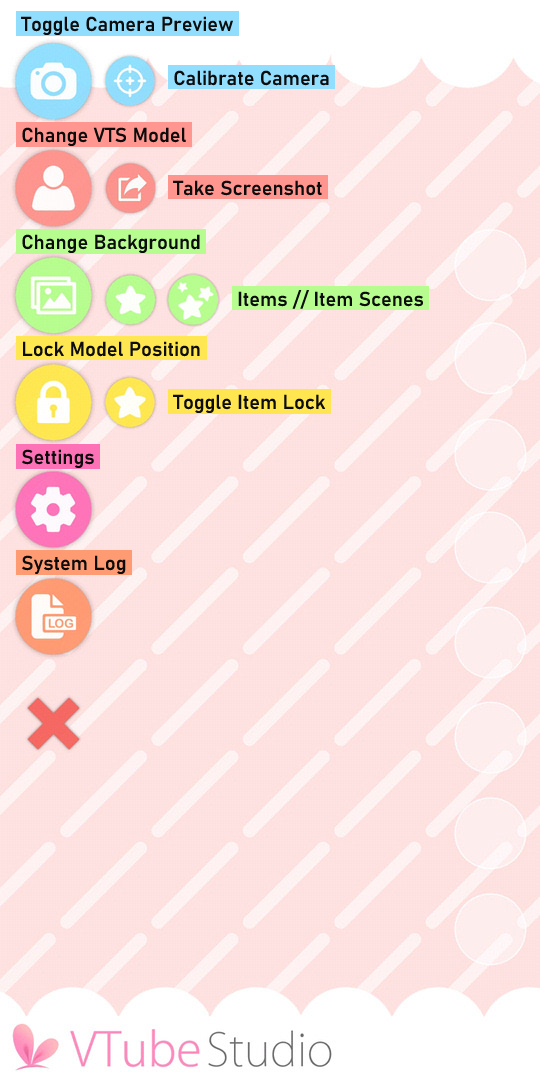

The table below describes what each menu option does. Some of the options have links to a separate wiki page where you can learn more about them.
| Option | Description | Mobile-/PC-Only? |
|---|---|---|
| Toggle Camera Preview | Turns the camera preview on/off | Mobile |
| Calibrate Camera | Calibrates the camera without showing the camera preview | Mobile |
| Change VTS Model | Opens the model selection bar | Both |
| Take Screenshot | Takes a screenshot directly in the app | Both |
| Change Background | Opens the background selector | Both |
| Items | Imports items into the scene | Both |
| Item Scenes | Sets up a collection of items that can be toggled via hotkeys | Both |
| Web Item | Adds an item directly into VTS through a Chromium web browser | PC |
| Lock Model Position | Locks the model in place so it can't be moved while touching the screen; does NOT disable face tracking | Both |
| Toggle Item Lock | Locks/unlocks all items in the scene | Both |
| Settings | Opens the Settings menu | Both |
| Steam Workshop | Opens the Steam Workshop menu | PC |
| System Log | Opens the System Log | Both |
| VNet Settings* | Opens the VNet collab menu | PC |
| Collab Participants* | Opens the collab control screen | PC |
*In order to set up multiplayer collabs directly in VTS, you must first purchase the VNet DLC.
You may notice there's no option to toggle the camera preview in the PC version. This is done intentionally for privacy/security reasons.
To close the app, you can double press/tap to bring up the main menu. Then go to Settings -> General Configuration -> Close App.
VTube Studio comes with a few example Live2D models for you to play around with. Aside from Akari, all of them belong to Live2D Inc., so if you want to use them in your streams please refer to Live2D's Licensing Agreement.
Of course, you can also load your own models into VTS! Pressing the "Change VTS Model" icon will bring up the model selection bar (see below).

On the model selection bar, pressing the "Import your own Model" button will open a dialog with instructions on how to structure the file path for your models to import them. The file path will differ depending on what platform you're using:
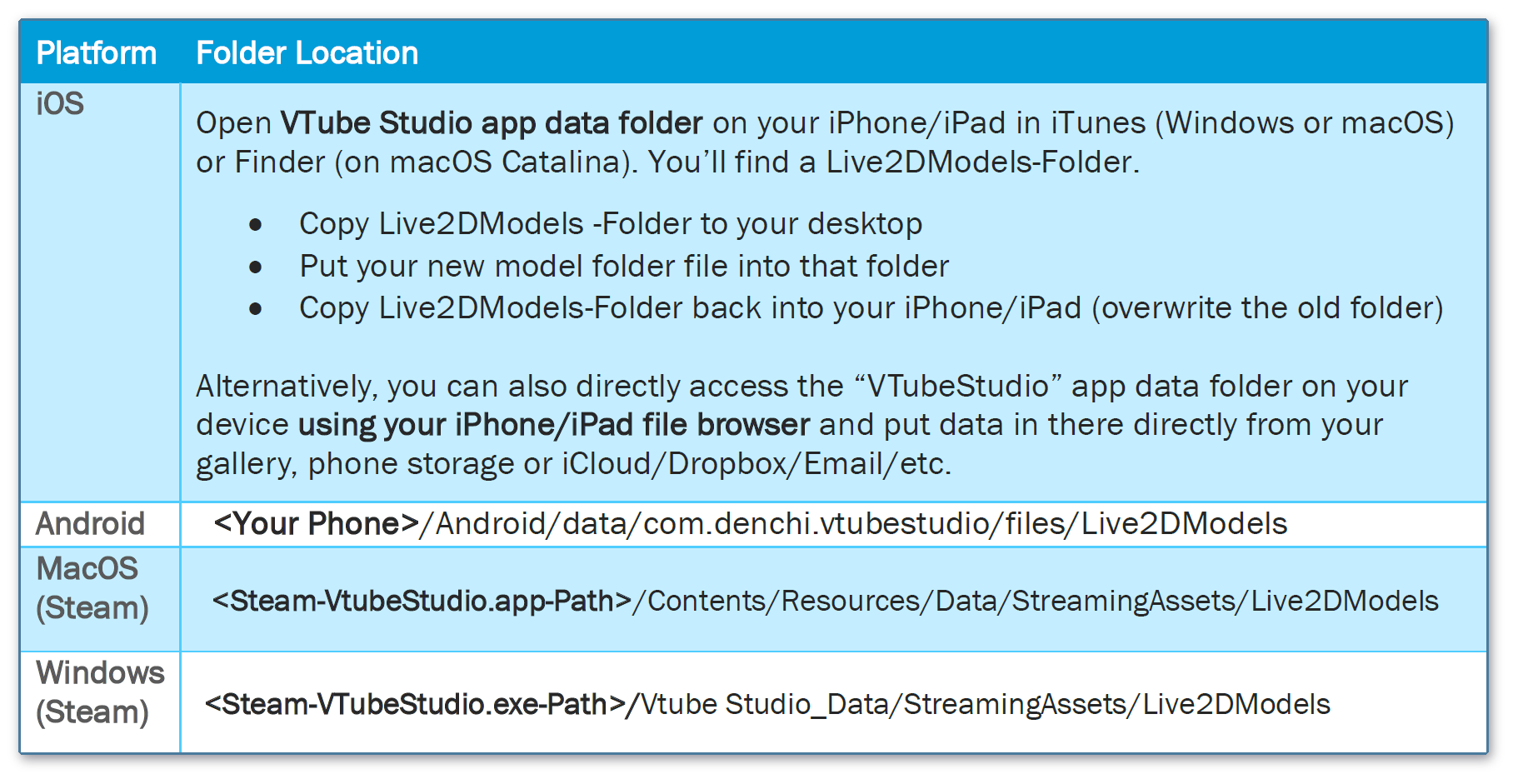
In the PC version of VTS, you can also directly open the folder you'll be putting your models into by pressing the "Open folder" button in the dialog that comes up after pressing "Import your own Model."

Alternatively, you can go to the Settings menu and navigate to General Settings & External Connections (first tab) -- under the "General Configuration" section, there will be a button titled "Open data folder." This button will open the StreamingAssets folder, which in turn contains the Live2DModels folder where you should put the folder containing all of your model's files.

Your model folder should, at minimum, contain the following:
- model3.json file (the model's index file)
- .moc3 file (the model's data file)
- physics3.json file (the model's physics file)
- The model's texture folder, usually named
<model>.<resolution>
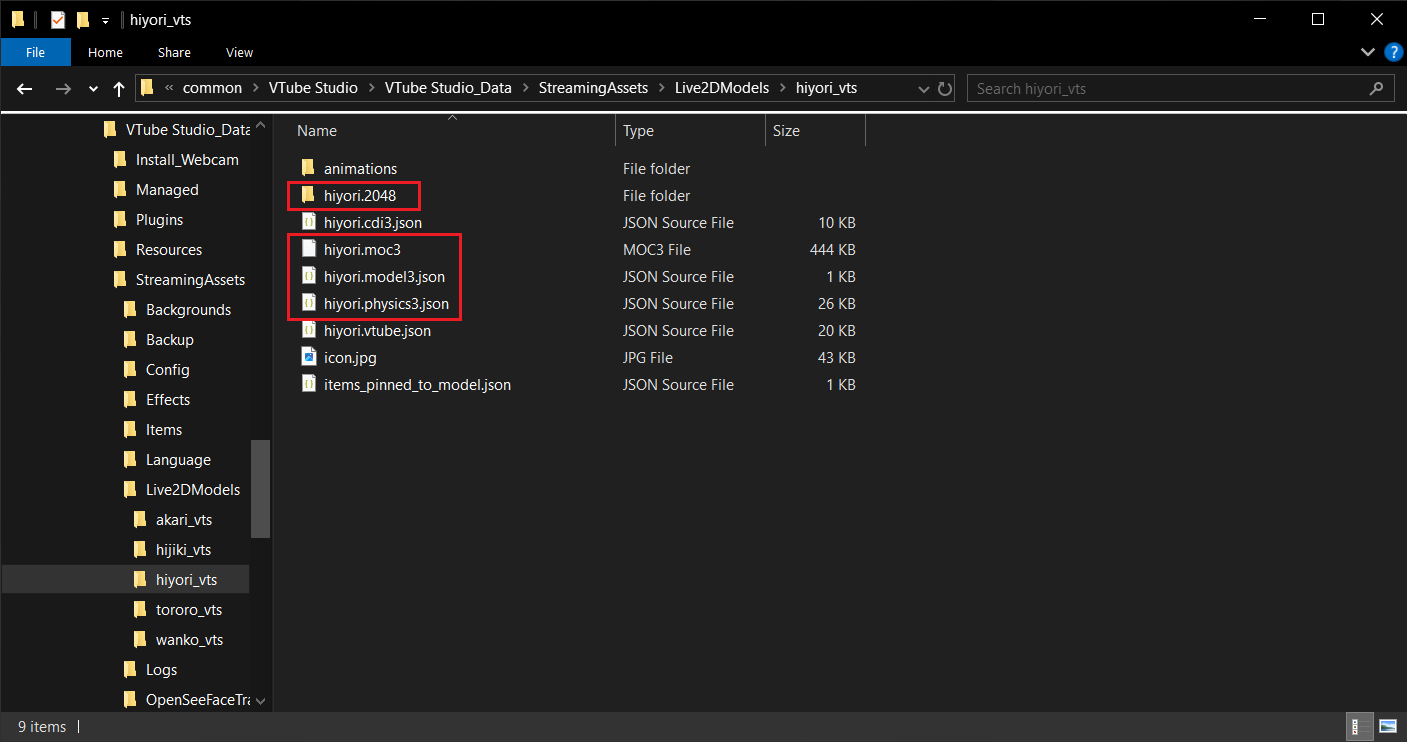
For more information on these files and what they do, refer to the section on Preparing your model for VTube Studio.
If you have Live2D animations or expressions for your model, those should also be placed directly in the folder or within a subfolder. Ideally you should also include a 512x512px image file (.png or .jpg) as the model's icon that will show up in the model selection bar.
If VTube Studio is already running when you import your model, restart the program. Whenever VTS starts up it will automatically look for new Live2D models and create a VTube Studio Model (<Live2D-Model-Name>.vtube.json) file in the same folder. This file is human-readable and contains all information about your VTube Studio model setup. More info on the VTube Studio Model here.
You should now be able to see your model in the model selection bar. If not, make sure all files are present and there are no errors in the logs.
After clicking a model, it will be loaded into the scene.
Note: You don't need to have the model on your smartphone if you just want to use the phone for tracking, but it can be nice for making short videos for Twitter/TikTok/YouTube Shorts.
You can use the method described above to load the model onto your phone manually. However, VTube Studio can also directly send your model from your PC to your smartphone. To do so, follow these steps:
- Load your model in VTS on your PC.
- Connect your smartphone to your computer via WiFi (Android & iOS) or USB (iOS only).
- On your PC, navigate to the third tab of the Settings menu in VTS (labeled "Model Settings"). Press the "Send Model to Phone" button on the right side of the screen and click "OK" on the subsequent pop-up.
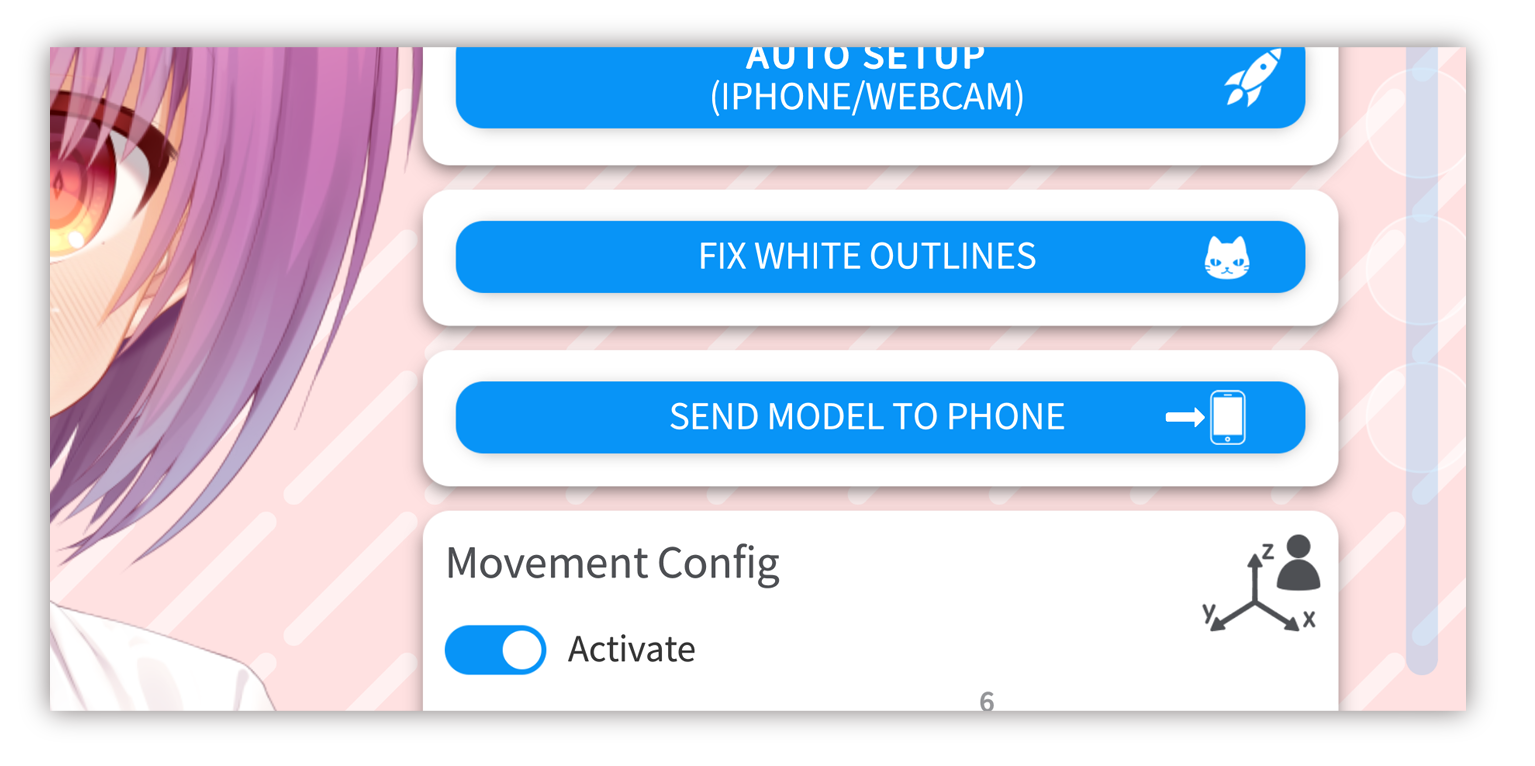
If you already have the model on your smartphone, doing this will overwrite the files.
When loading a new model into VTube Studio for the first time, you'll be asked to run the "Auto-Setup." This will set the model up based on default Live2D parameter names and value ranges. You can also run Auto-Setup manually, under Settings > Model Settings > Auto Setup.
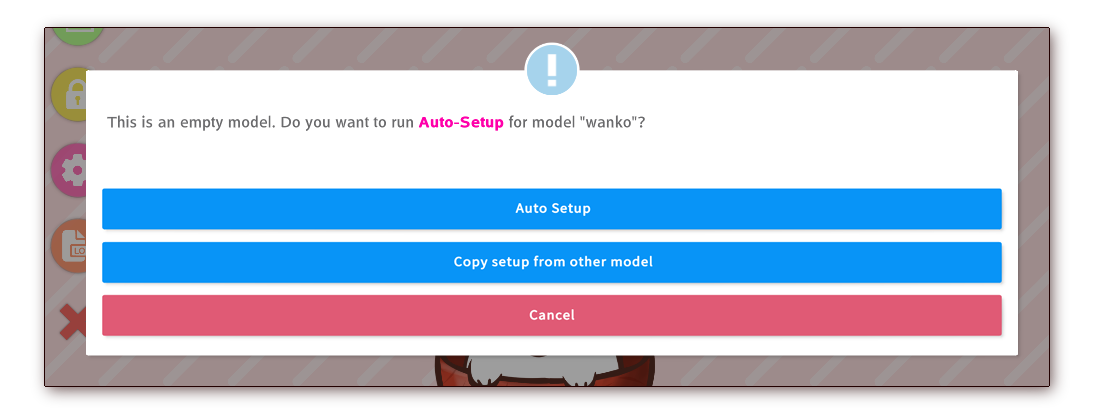
When running the Auto-Setup, VTube Studio will automatically look for default Live2D parameters in your model. VTube Studio will assume that you have used default Live2D parameter IDs and parameter names and set up your VTube Studio accordingly. You can learn more about the default IDs on the Live2D website.
If your model is not set up using the default IDs, you will have to set your model up manually. This is explained in detail in the wiki page on "VTS Model Settings."
Alternatively, you can copy the setup from another model in this menu, including the parameter setup, expressions, animations and more. For more info about that, refer to the wiki page on "Copying config between models."
Once your model is configured, it will mirror your movement and facial expressions. If you want to move, rotate, or rescale the model, you can do so with touch gestures on your smartphone or the on-screen controls on PC.
On iOS, you may have to open the camera preview once after installing the app before the model will move.
At this point, you may want to double-check your camera calibration and note how the tracking is reflected in your model's movements. On smartphone, if you want to re-calibrate the camera, you can either press the "Calibrate Camera" button or directly press the camera preview window. If you're using a webcam on your PC, go to Settings > Webcam, Tracking, Video & Visual Settings (second tab) > Camera ON > Calibrate.
When calibrating your camera, make sure to keep your face at a normal distance from the camera with a neutral expression on your face. This is especially important for Android/webcam; iOS only needs calibration to reset the face direction.
If you're using VTS on your phone, once your model is set up and calibrated, you can close the camera preview at any time. There is no reason to keep it open.
Now your model is all set up, and you're ready to start streaming!
For a step-by-step video explanation on how to load your Live2D model, check out this link:
[VTube Studio] Loading your own Live2D Models - https://www.youtube.com/watch?v=AssUd6EtFXw
![]() If you have any questions that this manual doesn't answer, please ask in the VTube Studio Discord
If you have any questions that this manual doesn't answer, please ask in the VTube Studio Discord![]() !!
!!
- Android vs. iPhone vs. Webcam
- Getting Started
- Introduction & Requirements
- Preparing your model for VTube Studio
- Where to get models?
- Restore old VTS Versions
- Controlling multiple models with one device
- Copy config between models
- Loading your own Backgrounds
- Recoloring Models and Items
- Record Animations
- Recording/Streaming with OBS
- Sending data to VSeeFace
- Starting as Admin
- Starting without Steam
- Streaming to Mac/PC
- VNet Multiplayer Overview
- Steam Workshop
- Taking/Sharing Screenshots
- Live2D Cubism Editor Communication
- VTube Studio Settings
- VTS Model Settings
- VTube Studio Model File
- Visual Effects
- Twitch Interaction
- Twitch Hotkey Triggers
- Spout2 Background
- Expressions ("Stickers"/"Emotes")
- Animations
- Interaction between Animations, Tracking, Physics, etc.
- Google Mediapipe Face Tracker
- NVIDIA Broadcast Face Tracker
- Tobii Eye-Tracker
- Hand-Tracking
- Lipsync
- Item System
- Live2D-Items
- Item Scenes & Item Hotkeys
- Add Special ArtMesh Functionality
- Display Light Overlay
- VNet Security
- Plugins (YouTube, Twitch, etc.)
- Web-Items
- Web-Item Plugins


